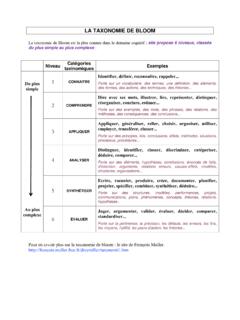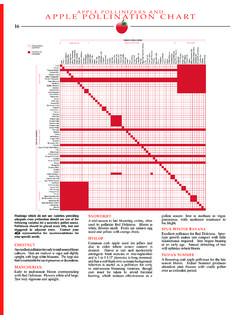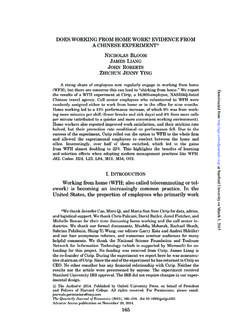Transcription of Climate change and infectious diseases
1 IntroductionThe previous chapter considered how short-term variations in climatic conditionsand extreme weather events can exert direct effects on human death rates, phys-ical injury, mental health and other health outcomes. Changes in mean climaticconditions and Climate variability also can affect human health via indirect path-ways, particularly via changes in biological and ecological processes that influ-ence infectious disease transmission and food yields. This chapter examines theinfluences of climatic factors on infectious centuries humans have known that climatic conditions affect epidemicinfections since well before the basic notion of infectious agents was under-stood late in the nineteenth century.
2 The Roman aristocracy took refuge in theirhill resorts each summer to avoid malaria. South Asians learnt early that in highsummer, strongly curried foods were less prone to induce diarrhoeal diseases . In the southern United States one of the most severe summertime outbreaks ofyellow fever (viral disease transmitted by the Aedes aegyptimosquito) occurred in1878, during one of the strongest El Ni o episodes on record. The economic andhuman cost was enormous, with an estimated death toll of around 20 000 developed countries today it is well known that recurrent influenza epidemicsoccur in disease transmission should be viewed within an ecological frame-work.
3 infectious agents obtain the necessary nutrients and energy by parasitiza-tion of higher organisms. Most such infections are benign, and some are evenbeneficial to both host and microbe. Only a minority of infections that adverselyaffect the host s biology are termed infectious disease .During the long processes of human cultural evolution; population dispersalaround the world; and subsequent inter-population contact and conflict; severaldistinct transitions in human ecology and inter-population interactions havechanged profoundly the patterns of infectious disease in human the early emergence of agriculture and livestock herding around 10 000years ago, three great transitions in human/microbe relationships are readily recognizable (1):103 CHAPTER 6 Climate change and infectious diseasesJ.
4 A. Patz,1A. K. Githeko,2J. P. McCarty,3S. Hussein, ,4N. de Wet51 Johns Hopkins University, Baltimore, MD, Medical Research Institute, Kisumu, of Nebraska at Omaha, Omaha, NE, o Oswaldo Cruz, Rio de Janeiro, International Global change Institute, University of Waikato, New Early human settlements enabled enzootic infective species to enter H. Early Eurasian civilizations came into military and commercial contact around2000 years ago, swapping dominant European expansionism over past five centuries caused transoceanic spread ofoften lethal infectious may be the fourth great transitional period. The spread and increased labil-ity of various infectious diseases , new and old, reflects the impacts of demo-graphic, environmental, technological and other rapid changes in humanecology.
5 Climate change , one of the global environmental changes now underway, is anticipated to have a wide range of impacts upon the occurrence of infec-tious disease in human classificationBroadly, infectious diseases may be classified into two categories based on themode of transmission: those spread directly from person to person (throughdirect contact or droplet exposure) and those spread indirectly through an inter-vening vector organism (mosquito or tick) or a non-biological physical vehicle(soil or water). infectious diseases also may be classified by their natural reser-voir as anthroponoses (human reservoir) or zoonoses (animal reservoir).
6 Climate sensitivities of infectious diseasesBoth the infectious agent (protozoa, bacteria, viruses, etc) and the associatedvector organism (mosquitoes, ticks, sandflies, etc.) are very small and devoid ofthermostatic mechanisms. Their temperature and fluid levels are therefore deter-mined directly by the local Climate . Hence, there is a limited range of climaticconditions the Climate envelope within which each infective or vector speciescan survive and reproduce. It is particularly notable that the incubation time ofa vector-borne infective agent within its vector organism is typically very sensi-tive to changes in temperature, usually displaying an exponential climatic sensitivities for the agent, vector and host include level of pre-cipitation, sea level elevation, wind and duration of and predictive Climate / infectious disease linkagesThe seasonal patterns and climatic sensitivities of many infectious diseases arewell known.
7 The important contemporary concern is the extent to which changesin disease patterns will occur under the conditions of global Climate change . Overthe past decade or so this question has stimulated research into three concen-trations. First, can the recent past reveal more about how climatic variations ortrends affect the occurrence of infectious diseases ? Second, is there any evidencethat infectious diseases have changed their prevalence in ways that are reason-ably attributable to Climate change ? Third, can existing knowledge and theorybe used to construct predictive models capable of estimating how future scenar-ios of different climatic conditions will affect the transmissibility of particularinfectious diseases ?
8 Modifying influencesClimate is one of several important factors influencing the incidence of infectiousdiseases. Other important considerations include sociodemographic influencessuch as human migration and transportation; and drug resistance and nutrition;as well as environmental influences such as deforestation; agricultural develop-104 Climate change AND HUMAN HEALTH ment; water projects; and urbanization. In this era of global development andland-use changes, it is highly unlikely that climatic changes exert an isolatedeffect on disease; rather the effect is likely dependent on the extent to whichhumans cope with or counter the trends of other disease modifying recognizing the important independent role of these non-climatic factors,the focus of this section is to examine the extent to which they may compoundthe effects of climatic conditions on disease classifications relevant to Climate /health relationshipsSeveral different schemes allow specialists to classify infectious diseases .
9 For clin-icians who are concerned with treatment of infected patients, the clinical man-ifestation of the disease is of primary importance. Alternatively, microbiologiststend to classify infectious diseases by the defining characteristics of the micro-organisms, such as viral or bacterial. For epidemiologists the two characteristicsof foremost importance are the method of transmission of the pathogen and itsnatural reservoir, since they are concerned primarily with controlling the spreadof disease and preventing future outbreaks (2). Climate variability s effect on infectious diseases is determined largely by theunique transmission cycle of each pathogen.
10 Transmission cycles that require avector or non-human host are more susceptible to external environmental influ-ences than those diseases which include only the pathogen and human. Impor-tant environmental factors include temperature, precipitation and humidity(discussed in more detail in the following section). Several possible transmissioncomponents include pathogen (viral, bacterial, etc.), vector (mosquito, snail,etc.), non-biological physical vehicle (water, soil, etc.), non-human reservoir(mice, deer, etc.) and human host. Epidemiologists classify infectious diseasesbroadly as anthroponoses or zoonoses, depending on the natural reservoir of thepathogen; and direct or indirect, depending on the mode of transmission of thepathogen.

















